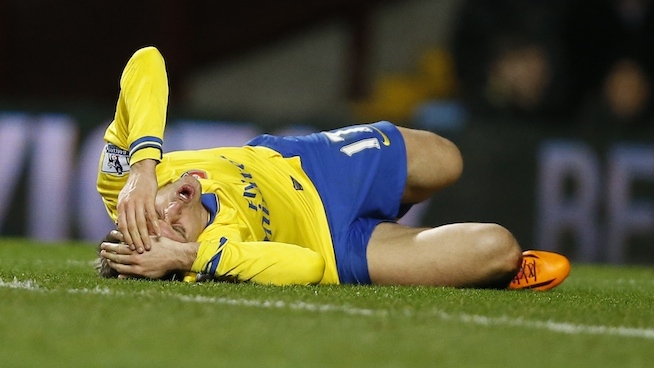Can Soccer Lead to Brain Trauma?

AP Images
Researchers at Boston University have found signs of chronic traumatic encephalopathy in the brain of a deceased 29-year-old former soccer player, The New York Times reports. This disease is more commonly associated with more violent contact sports like football, hockey and boxing.
The former player, Patrick Grange of Albuquerque, N.M., died in April from amyotrophic lateral sclerosis (commonly known as ALS or Lou Gehrig’s disease).
Although soccer isn’t usually associated with repeated blows to the head, Grange’s parents told the Times their son was especially proud of his ability to head the ball. They recalled him tossing a ball into the air and heading it into a goal “endlessly” when he was as young as 3 years old.
“He had very extensive frontal lobe damage,” Dr. Ann McKee, the neuropathologist who performed the brain examination, told the Times. “We have seen other athletes in their 20s with this level of pathology, but they’ve usually been football players.”
It’s interesting to note that the area of Grange’s head that contacted the ball most often was the area that was damaged. Still, Dr. McKee cautions against drawing any conclusions from this. He said, “We can’t say for certain that heading the ball caused his condition in this case. But it is noteworthy that he was a frequent header of the ball, and he did develop this disease. I’m not sure we can take it any further than that.”
Grange’s case doesn’t mean that soccer is inherently dangerous, but it does raise the level of concern about the risks of repeated concussive and sub-concussive blows to the head. If you think you have a concussion, tell your coach or athletic trainer. Worried athletes or parents can invest in a device like the Reebok Checklight, which indicates if an athlete needs a concussion test after a blow to the head.
RECOMMENDED FOR YOU
Can Soccer Lead to Brain Trauma?

AP Images
Researchers at Boston University have found signs of chronic traumatic encephalopathy in the brain of a deceased 29-year-old former soccer player, The New York Times reports. This disease is more commonly associated with more violent contact sports like football, hockey and boxing.
The former player, Patrick Grange of Albuquerque, N.M., died in April from amyotrophic lateral sclerosis (commonly known as ALS or Lou Gehrig’s disease).
Although soccer isn’t usually associated with repeated blows to the head, Grange’s parents told the Times their son was especially proud of his ability to head the ball. They recalled him tossing a ball into the air and heading it into a goal “endlessly” when he was as young as 3 years old.
“He had very extensive frontal lobe damage,” Dr. Ann McKee, the neuropathologist who performed the brain examination, told the Times. “We have seen other athletes in their 20s with this level of pathology, but they’ve usually been football players.”
It’s interesting to note that the area of Grange’s head that contacted the ball most often was the area that was damaged. Still, Dr. McKee cautions against drawing any conclusions from this. He said, “We can’t say for certain that heading the ball caused his condition in this case. But it is noteworthy that he was a frequent header of the ball, and he did develop this disease. I’m not sure we can take it any further than that.”
Grange’s case doesn’t mean that soccer is inherently dangerous, but it does raise the level of concern about the risks of repeated concussive and sub-concussive blows to the head. If you think you have a concussion, tell your coach or athletic trainer. Worried athletes or parents can invest in a device like the Reebok Checklight, which indicates if an athlete needs a concussion test after a blow to the head.










